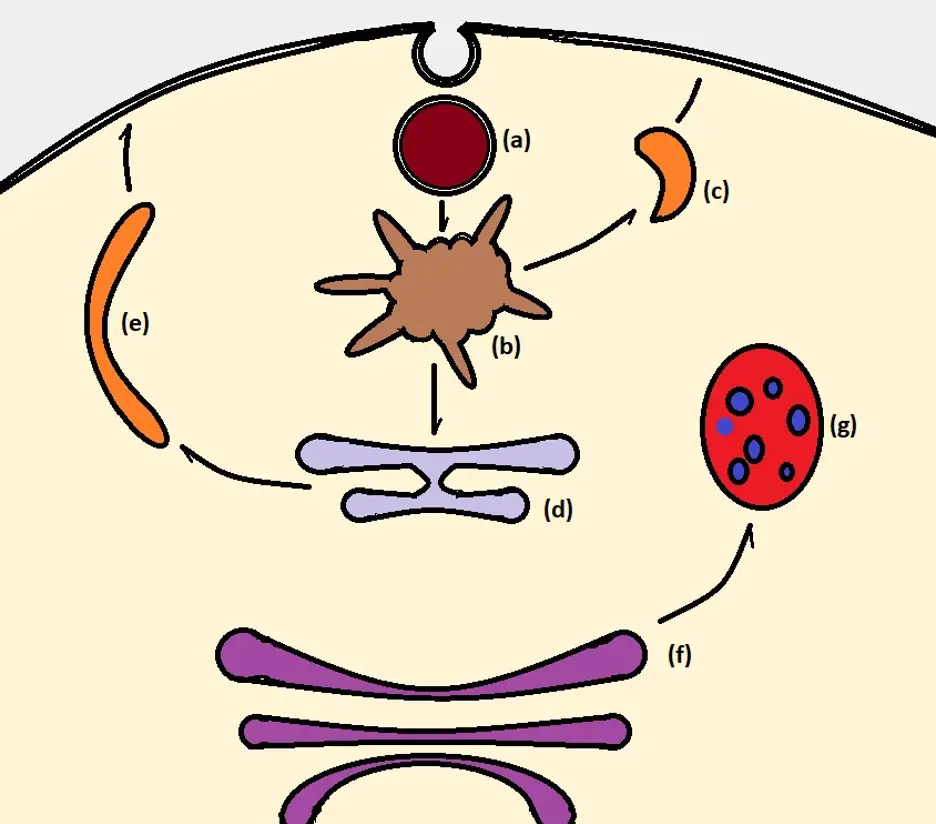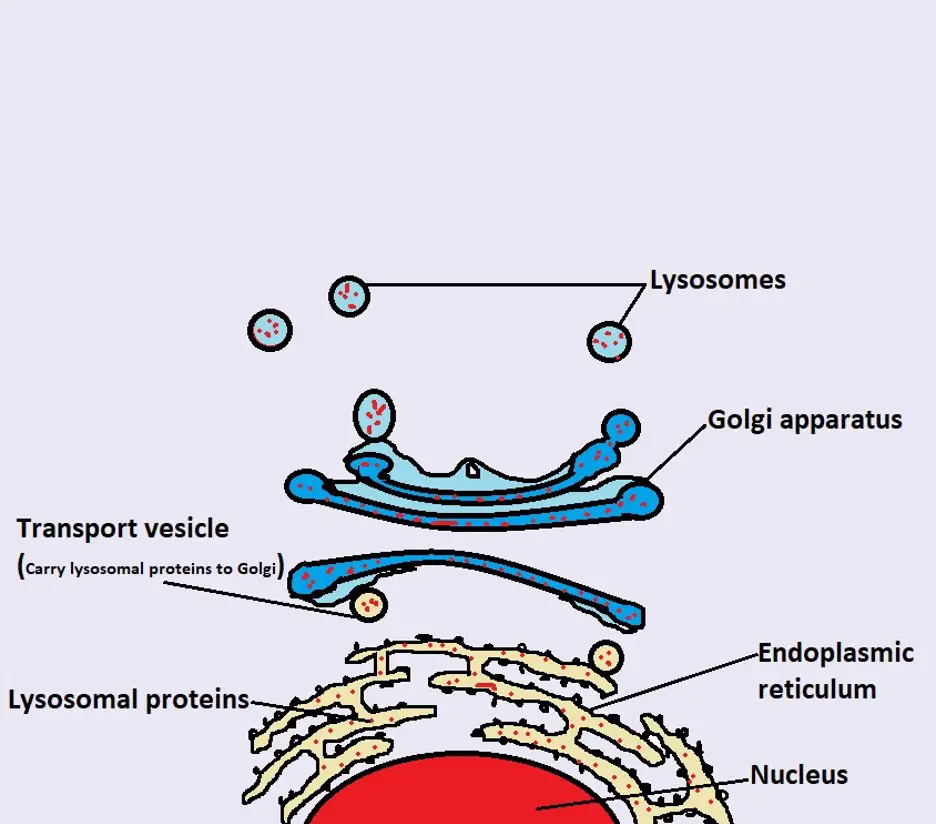Endosomes
Function, Lysosomes, and Exosomes
Endosomes are membrane-bound vesicles that are involved in the transportation and sorting of internalized material.
Depending on the activity within these vesicles, endosomes are divided into three main categories that include:
- Early endosome
- Recycling endosome
- Late endosome
Function
Over the course of endosome maturation, the different types of endosomes have been shown to serve different roles within the cell.
This section will focus on the functions of each endosome in detail:
Early Endosomes
The early endosome is the first membrane-bound compartment that receives endocytic cargo (internalized material from the cell membrane). Their membranes consist of phosphoinositide phosphatidylinositol 3-phosphate and have been shown to exhibit dynamic movement.
Within the cell, the early endosomes fuse together as well as with the endocytic vesicles (internalized vesicles that contain material being internalized). They are also characterized by an internal pH of about 6.2 which is maintained by the action of the V-ATPase proton pump.
In most cells, the early endosome has also been shown to have a complex compartment characterized by two important regions which include tubular extensions of about 60nm in diameter and large vesicles of about 400nm.
Because of the invaginations on the membrane of the large vesicles, it may look like several vesicles when viewed under the microscope (powerful electron microscope). In the lumen of the large vesicles, the pH ranges from 6.2 to 5.5 while the tubular extensions have a pH of about 6.5. This, along with the differences between the two regions plays an important role in the sorting of material within the early endosome.
Because of the moderately acidic environment within the endosome, ligands that had bound the receptors, before and during internalization, are dissociated from the receptors. Receptors and a number of other proteins then accumulate in the tubular region of the endosome while the ligands accumulate in the large vesicles.
This process is known as sorting and may take a few minutes after the early endosomes receive internalized material. Contents of the tubular endosome are then transported to the cell surface so that they can be re-used (recycling) while contents of the large vesicles are taken to the late endosome for degradation.
* While the pH level plays an important role in dissociation of ligands from the receptors, isolation of receptors (and some proteins and lipids) from the degradation pathway has been shown to be dependent on sorting signals (e.g., epidermal growth factor receptor).
Recycling Endosome
The recycling pathway is divided into two main categories that include the fast-recycling pathway and the slow recycling pathway:
Fast Recycling Pathway
The fast-recycling pathway is also known as a rapid or direct recycling route. Here, materials to be recycled are transported directly from the early endosomes to the plasma membrane. This is regulated by Rab4 and Rab35.
In addition to transferrin receptors (TfR), some of the other materials that are recycled include T-ce receptor, Major Histocompatibility Complex I and Major Histocompatibility Complex II. Recycling of these materials occurs through the Rab35‐dependent pathway. Rab 14, on the other hand, is involved in the recycling of transmembrane protease ADAM10.
Some of the other functions of Rab4 and Rab35 include:
- Regulating phagosome maturation
- Regulating Golgi to endosome transport
- Controlling endosome and phagosome fusion
Slow Recycling Pathway
Also known as the indirect recycling route, this pathway involves the transportation of material to the endocytic recycling compartment (a perinuclear location) before they are taken to the plasma membrane. Unlike rapid recycling, slow recycling is regulated by Rab11a.
By localizing the tubular endosome, the endocytic recycling compartment, and trans‐Golgi network, Rab11a influences the transport of material to the endocytic recycling compartment from the sorting endosomes (from trans‐Golgi network) and ultimately to the plasma membrane.
Some of the material recycled through this pathway include junction proteins, immune receptors, integrins, and transferrin receptors among others.
* About 95 percent of the endocytosed membrane is recycled.
Late Endosome
While some materials are recycled back to the membrane, others (e.g., ligands) are retained in the early endosome as it matures into a late endosome. This endosome is characterized by a multivesicular structure. This is produced during the maturation process through the formation of multivesicular bodies.
During the maturation phase, sites of the endosome membrane that contain membrane proteins curve in towards the lumen of the endosome to form luminal vesicles. This ensures that the proteins, as well as retained receptors, are brought into the lumen where degradation takes place.
Maturation of the late endosome also involves a process known as glycosylation. Here, the enzyme transferase attached carbohydrates (covalently) to the proteins in the endosome membrane to form the glycocalyx (a thick layer that protects the cytosol from enzymatic actions within the lumen of the endosome).
The proton pump then forces protons into the endosome which causes the pH (about 4.6) to drop thus increasing the acidity of the late endosome. At this stage of maturation, lysosomal enzymes are transported into the endosome through the mannose-6-phosphorylase system from the trans-Golgi.
Here, the M6PR receptor binds to and transports the enzyme-containing vesicles (hydrolytic enzymes) from the Golgi to the endosome where they are involved in degradation.
Within the late endosome, the enzymes help in the degradation of a number of materials including DNA, RNA, proteins, and lipids. This breakdown of large molecules results in the production of smaller components such as nucleotides and amino acids.
Following the degradation of material in the late endosome, the smaller/simpler components may then be taken to the cytosol where they can be used by the cell.
* While endosomes play an important role of trafficking material from the extracellular environment into the cell through the endocytic pathway, it's also worth noting that they receive some synthesized material from the biosynthetic pathways.
For instance, when proteins are synthesized in the endoplasmic reticulum, they are transported to the Golgi and ultimately received by the endosome so that they can be transported to their destination (e.g., vacuoles or the lysosome)
The following is a diagrammatic representation of the functions of the three types of endosomes:
(a) - Early endosome that contains internalized material
(b) - Sorting endosome where materials are segregated
(c) - Direct of fast recycling pathway
(d) - Endocytic recycling compartment – Materials are transported to the endocytic recycling compartment before being transported to the membrane
(e) - Slow recycling pathway
(f) - Golgi - the source of lysosomal enzymes
(g) - Late endosome in which materials are degraded
Lysosomes
Lysosomes are specialized vesicles that contain more than 50 hydrolytic enzymes (69 hydrolytic enzymes according to some literature). These enzymes allow for the breakdown of a number of molecules including polysaccharides, lipids, proteins, and nucleic molecules through hydrolysis. Like many other organelles found in eukaryotic cells, lysosomes are membrane bound organelles with a spherical shape.
While the endosomes play an important role in the internalization and transport of various materials, as well as sorting, within the cell, it's lysosomes that carry enzymes that degrade some of these materials. For this reason, they are often associated with endosomes.
Like many other proteins, lysosomal proteins (enzymes) are synthesized within the rough endoplasmic reticulum (which is covered by ribosomes where proteins are produced). The proteins (enzymes) are then transported to the Golgi by transport vesicles where they are linked to mannose-6-phosphate before the bud off from the Golgi apparatus.
In the cytoplasm, the vesicle is especially important given that it contains the hydrolytic enzymes that would otherwise cause damage to other cellular components.
* In the cytoplasm, the enzyme-containing vesicles (lysosomal enzymes) then fuse with the late endosome in which degradation takes place. Here, the endosome provides conditions (low pH) necessary for enzyme activities.
Some of the other functions of lysosomes include:
- Gene regulation
- Destruction of microbial organisms
- Cell adhesion
- Metabolic signaling
- Detoxification
- Apoptosis
- Repair of the plasma membrane
- Cell migration
Exosomes
Exosomes may be described as endosomal-derived nanovesicles that carry lipids, proteins, and nucleic molecules which may then be taken up by neighboring cells. For this reason, exosomes are sometimes referred to as extracellular vesicles.
While they carry various biomolecules outside the cell which are then taken up by other neighboring cells, exosomes, like lysosomes, are also associated with endosomes.
As mentioned, the late endosomal membrane tends to undergo invagination (curving inwards towards the lumen) resulting in the formation of intraluminal vesicles.
Here, some components from the cytosol may be engulfed into these vesicles. Some of these vesicles which are now known as exosomes, are then released outside the cell when they fuse with the cell membrane.
Although there are several methods of cell communication including direct cell to cell contact as well as through the release of hormones and cytokines etc., exosomes have also been shown to be involved in this activity.
Once they are released from a cell, they can interact and even be taken up by neighboring cells and consequently influence the response of these cells (recipient cells).
Here, however, the impact they will have on the neighboring cells is largely dependent on the cargo they are carrying. Given that they can transport various components into cells, researchers have been studying ways through which they can use these vesicles to transport drugs into cells for the treatment of various diseases.
See also: Endocytosis Vs Exocytosis, Exosomes and Stem Cells
Do animal cells have vesicles?
Return from Endosomes to MicroscoepMaster home
References
James R Goldenring. (2015). Recycling endosomes
Jatta Huotari and Ari Helenius. (2011). Endosome maturation.
Marko Jovic, Juliati Rahajeng, Steve Caplan, and Mahak Sharma. (2010). The early endosome: A busy sorting station for proteins at the crossroads.
Samual C. Allgood M and Ramona Neunuebel. (2018). The recycling endosome and bacterial pathogens.
Links
https://www.intechopen.com/books/peripheral-membrane-proteins/rapid-endosomal-recycling
Find out how to advertise on MicroscopeMaster!






